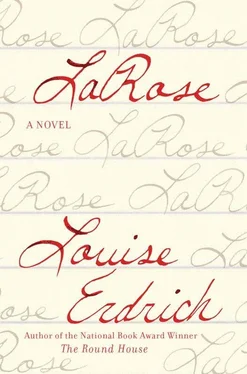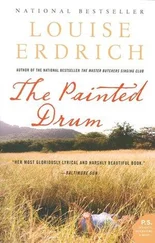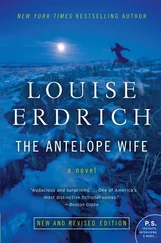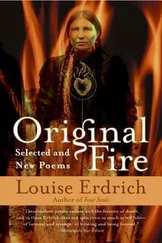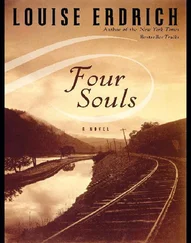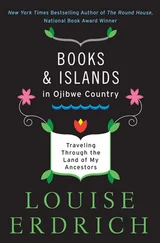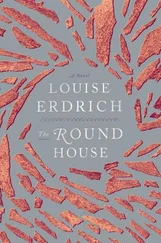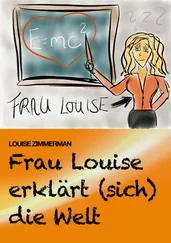The second LaRose was saturated. She was smart. After the agony of getting used to her corsets she pulled them tight and wore gloves — because her mother had on special occasions worn gloves. She learned to clean white people’s houses during Carlisle’s outing program, gouging congealed dust from corners with a knife. Polishing the gray veins of marble floors. She made the woodwork glow. Sparkled up the copper boilers. Also, she wrote in lovely script and factored into the thousands. She knew the rivers of the world and the wars the Greeks fought, the Romans fought, the Americans fought, beating the British and then the savages. A list of races she had to memorize placed white the highest, then yellow, black, and finally savage. According to the curriculum, her people were on the bottom.
So what. She wore hats and buttoned up her shoes. She knew the Declaration of Independence by heart and Captain Pratt himself had spoken to her of the Civil War and why it was fought. She gave recitations including a poem about the angel in the kitchen. She learned mathematics and memorized the shape of the countries on the globe. She learned American history and the levels of civilization ancient to modern, which culminated in men like Captain Richard Pratt. She learned how to survive on bread and water, then coffee, gravy, and bread. Mostly she learned how to do menial labor — how to use a mangle, starch, an iron. She worked ten-hour days in 120 degree heat. She learned how to sew with a machine. How to imagine her own mouth sewed shut. For speaking Anishinaabe. She learned how to endure being beaten with a board. How to eat with a fork, a spoon, how to lard bread correctly with a knife, how to grow vegetables, how to steal them, how to make soap, scrub floors, scrub walls, scrub pots, scrub the body, scrub the head, scrape a floor clean, a commode, a pantry shelf by shelf, what rats were and how to kill them, how to supplement her diet by stealing from the surrounding farms or gathering nuts and acorns, hiding them in her bosom. During those early years, Carlisle sold its farm produce and fed the students oatmeal, oatmeal, oatmeal.
She learned how to stand correctly, shake hands firmly, pull on gloves and take them off finger by finger. How to walk like a white woman on hard shoes. How to use and wash out stinking menstrual rags when Ojibwe women never stunk of old blood as they used and discarded moss and cattail down, bathed twice a day. She learned to stink, learned to itch, learned to boil her underwear for lice and wash only once a week, once every two weeks, three. She learned to sleep on cold floors, endure the smell of white people, and set a proper table. She learned how to watch her friends die quickly from measles or chokingly from pneumonia or shrieking from the agony of encephalitic meningitis. She learned how to sing funeral hymns, and she sang them for a Sioux boy named Amos LaFromboise, for a Cheyenne boy named Abe Lincoln, for Herbert Littlehawk, Ernest White Thunder, Kate Smiley, and for a suicide whose name she carefully brushed from her mind. She learned how to go hungry and how to stay full even if she had to eat bark — the innermost layers of birch. She learned, like her mother, how to hide that she had tuberculosis.
Pratt also said: A great general has said that the only good Indian is a dead one, and that high sanction of his destruction has been an enormous factor in promoting Indian massacres. In a sense, I agree with this sentiment, but only in this: that all the Indian there is in the race should be dead. Kill the Indian in him, and save the man.
They hadn’t started the killing early enough with this LaRose, though. She knew “The Battle Hymn of the Republic,” and yet her mother had taught her how to use fierce and subtle Ojibwe poisons. She knew how to catch and skin any animal she saw. Her mother had snared the head of a demon white man and burnt its eyes out. Her mother had called for her mother’s drum and cured a man who wandered in black vertigo. Her mother had made a new drum for her daughter. Nobody took it because she left it with her father. Now this LaRose had seen the ocean. Now her work out east was done. Her mother had taught her to put her spirit away for safekeeping when that was necessary. Out of the treetops, she brought back and absorbed her many selves. She was complete. She could go. Beneath the bobbing plume on the cast-off hat she was given for a month’s wages cleaning pots, she moved demurely along the railway platform, in her purse a ticket home.
She wanted to change everything about everything when she got home. She was able to amend a few things in small ways. She lived with her father, Wolfred. She married a cousin. She was a teacher and the mother of a teacher. Her namesake daughter became the mother of Mrs. Peace. All of them learned two languages, four levels of math, the uses of plants, and to fly above the earth.

HER FATHER SIPPED his whiskey. He still hadn’t spoken, but now a pile of papers rested under the hand that didn’t hold the whiskey cup.
Will you tell me, at least, where she is buried? asked LaRose.
I can’t tell you that, said Wolfred.
Why? She came close, touched his shoulder.
Because I don’t know.
In spite of her conflicting thoughts, LaRose had always tried to be realistic, to imagine a grave, a stone with her mother’s name on it, a place she could eventually go to visit. What her father said made no sense.
That can’t be, she said.
It is true, he said. Then he repeated the words she had forgotten and remembered many times since she was young.
She was stolen.
He patted the pile of papers, looked straight at her.
Daughter, it is all right here.
MRS. PEACE AT her sparkle-chrome kitchen table. The lacquered surface covered with beading trays, cigar boxes of beads, stacked papers. Snow and Josette carefully slipped very old letters into page protectors. Most of the paper that Wolfred Roberts had written on through the 1860s, then 1870s, was still thick and supple. Some was more brittle, lined, torn from ledgers.
That old-time paper was made so well, said Mrs. Peace. Stuff nowadays crumbles in a few years.
It’s the acid, said Snow. There’s acid in most paper now.
Wolfred Roberts had written fair copies of the letters he had sent in order to recover his stolen wife, fiercely building an archive in his quest. The dates were on the letters, and there was a record of the dates they were mailed, and dates upon which he received replies, if there were replies.
The original backup plan, said Josette.
He used his training as a fur trade clerk, said Mrs. Peace. Keeping track of every transaction. My aunt told me that he kept these letters in a metal box, locked. She was young when he died, but she remembered that little key. It was kept in an old sugar jar, the handles broken off. He worried that kids would mess around with these papers. This here was all he had of her, proof he looked for her.
Mrs. Peace locked the plastic pages into a ring binder. The first letters were addressed to Dr. Haniford Ames. Each of the letters from Wolfred, later from a lawyer also, requested the remains of LaRose Roberts. Her chipped incisor, fractured and knit skull, injuries from the vicious kick of a dissolute fur trader, as well as her tubercular bones, would make her distinctive. His letters searched after her, then the letters went on. Wolfred’s daughter, the second LaRose, kept them going. There were also letters from her time in Carlisle. And then the letter writing passed on to her daughter and then to Mrs. Peace. For well over a century these letters had searched after the bones of Mirage, the Flower, LaRose.
Читать дальше
